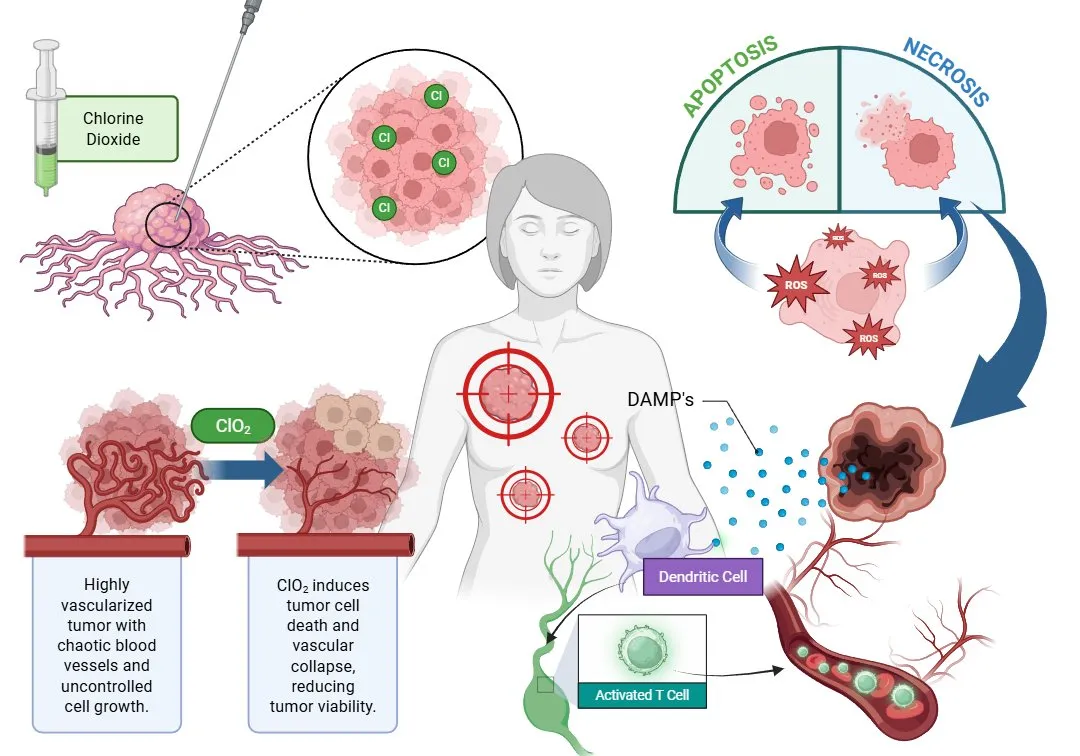What if the solution to destroy tumors lay in a substance we’ve only ever associated with industrial cleaning? Far from traditional chemotherapy or targeted therapies, a team of Chinese scientists has explored a path as unexpected as it is promising: the direct injection of chlorine dioxide (ClO2) into tumors as a highly effective and localized way to attack cancer.
In a study led by Xuewu Liu and collaborators, from institutions including Beijing Wanbincell Biotechnology and the Chinese Academy of Medical Sciences, researchers investigated how this compound (commonly used in water purification) can act as a powerful therapeutic agent when administered directly into tumors.
Chlorine dioxide is an oxidizing agent that, under specific conditions, behaves similarly to reactive oxygen species (ROS). These are molecules naturally produced by the human body to combat infections or eliminate abnormal cells, such as cancer cells. When introduced into the tumor microenvironment, ClO2 mimics ROS by causing direct damage to cancer cells through mechanisms such as apoptosis, a controlled form of cell death in which the cell “shuts itself down” when it detects internal damage, and necrosis, a more chaotic form of cell death where the cell bursts suddenly, spilling its contents and causing inflammation around it.
What’s remarkable is that this destruction does not depend on specific receptors or complex molecular pathways. Instead, chlorine dioxide causes a chemical and physical collapse of the cell, which is a major advantage over conventional treatments whose effectiveness can be compromised by mutations or drug resistance.
Beyond the direct cytotoxic effect on the tumor, the researchers observed something even more profound: a secondary immune response. This occurs because when tumor cells die (especially by necrosis) they release “alarm” molecules known as DAMPs (damage-associated molecular patterns). These signals are picked up by immune cells called dendritic cells, which act like the body’s sentinels and messengers. Dendritic cells collect this information and travel to the lymph nodes, where they present it to T cells, the immune system’s specialized attack force. Thanks to this process, the immune system can learn to recognize the tumor as a threat and begin fighting it elsewhere in the body.
In animal models (mice with breast cancer, melanoma, and lung cancer) significant reductions in tumor volume were observed, especially with ClO2 concentrations ranging from 8 to 15 mg/mL. For instance, in the B16 melanoma model, tumor growth was inhibited by 74.1% after just three doses. Even more telling was that in mice with two tumors (only one treated), both tumors shrank, suggesting an immune-mediated systemic effect triggered by the local treatment.
Chlorine dioxide also demonstrated tissue-regenerating properties. In wound-healing experiments, its application accelerated recovery in mice compared to saline or hydrogen peroxide treatments. This is particularly relevant in oncology, where tumors are often described as “wounds that do not heal,” and a treatment that both eliminates the tumor and promotes tissue repair represents a comprehensive therapeutic approach.
Of course, this type of intervention is not without risks. When ClO2 was administered systemically (via intravenous injection), adverse effects such as tail necrosis in mice were observed, indicating vascular damage. That’s why the authors strongly emphasize that the intratumoral route is the safest and most effective, allowing for a concentrated effect at the tumor site while minimizing exposure to the rest of the body.

Figure 1. Chlorine dioxide (ClO2) injected directly into the tumor induces cancer cell death through oxidative stress, causing both apoptosis and necrosis. This leads to tumor regression and vascular collapse. The release of DAMPs activates dendritic cells, which trigger T cell responses capable of attacking tumors at distant sites, suggesting a localized treatment with systemic immune effects.
It’s important to clarify that chlorine dioxide is not the same as bleach. Although both are oxidants, bleach is made of sodium hypochlorite (NaClO), and their chemical behavior and effects on living tissues are quite different. In the conditions studied, chlorine dioxide demonstrated a more favorable safety profile when used appropriately.
The research team led by Liu proposes a disruptive possibility in oncology: using a well-known oxidant, in precise doses and applied locally, to destroy tumors, activate the immune system, and promote tissue healing. While still in the preclinical phase, the findings open the door to new therapeutic strategies that are accessible, effective, and far less invasive.
Main Reference:
Liu, Xuewu and Liu, Zhaoyang and Liu, Xueyan and Liu, Shuangning and Zhang, Jiao, Intratumoral Delivery of Chlorine Dioxide Exploits its Ros-Like Properties: A Novel Paradigm for Effective Cancer Therapy. Available at SSRN: https://ssrn.com/abstract=5039849 or http://dx.doi.org/10.2139/ssrn.5039849
Other References:
Trachootham, D., Zhou, Y., Zhang, H., Demizu, Y., Chen, Z., Pelicano, H., Chiao, P. J., Achanta, G., Arlinghaus, R. B., Liu, J., & Huang, P. (2006). Selective killing of oncogenically transformed cells through a ROS-mediated mechanism by beta-phenylethyl isothiocyanate. Cancer cell, 10(3), 241–252. https://doi.org/10.1016/j.ccr.2006.08.009
Huang, P., Feng, L., Oldham, E. A., Keating, M. J., & Plunkett, W. (2000). Superoxide dismutase as a target for the selective killing of cancer cells. Nature, 407(6802), 390–395. https://doi.org/10.1038/35030140
Warkad, M. S., Kim, C. H., Kang, B. G., Park, S. H., Jung, J. S., Feng, J. H., Inci, G., Kim, S. C., Suh, H. W., Lim, S. S., & Lee, J. Y. (2021). Metformin-induced ROS upregulation as amplified by apigenin causes profound anticancer activity while sparing normal cells. Scientific reports, 11(1), 14002. https://doi.org/10.1038/s41598-021-93270-0


